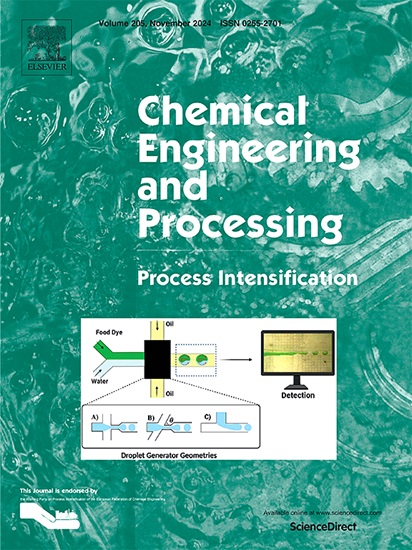Enzymatic hydrolysis of used cooking oil and palm olein using a Starbon-immobilized Candida Antarctica lipase B
IF 3.8
3区 工程技术
Q3 ENERGY & FUELS
Chemical Engineering and Processing - Process Intensification
Pub Date : 2025-07-11
DOI:10.1016/j.cep.2025.110443
引用次数: 0
Abstract
This study investigated the enzymatic hydrolysis of UCOs and refined palm olein using Candida Antarctica lipase B (CALB) immobilized on a mesoporous carbon (Starbon A800), and commercial immobilized lipases (Lipozyme TLIM and Novozyme 435). Various immobilization techniques were assessed, with physisorption onto an amino-functionalized surface followed by crosslinking (CALBAC3) providing the best results, achieving the highest enzyme loading (11.3 wt. %), anchoring efficiency (56.36 %), and hydrolytic activity (136.5 LU/g). Activity remained stable at pH 6–7.3, with optimal performance at 45–50 °C. The best hydrolytic activity was achieved at 45 °C, pH 7, 7.0 wt. % enzyme loading, ultrasonic mixing during initial 120 min at 100 W and 37 kHz, a 1:30 oil-to-water ratio, and mechanical stirring at 300 rpm. Under these conditions, conversion reached 91.04 ± 3.92 %. The obtained data were used to correlate kinetic expressions using the Michaelis-Menten-type and water-inhibition models, and they agreed reasonably well with experiments showing relative errors below 2 %. Despite high initial activity comparable to Novozyme 435, CALBAC3 exhibited a significant drop in performance after reuse, likely due to mechanical instability of the support and enzyme immobilization strength. Future work should focus on enhancing the support strength, optimizing mesoporous pore distribution, and exploring alternative crosslinking strategies.

用星固定化南极假丝酵母脂肪酶B酶解废食用油和棕榈油
本研究利用固定化介孔碳(Starbon A800)上的南极念珠菌脂肪酶B (CALB)和固定化商业脂肪酶(Lipozyme lim和Novozyme 435)研究了UCOs和精制棕榈油的酶解。对各种固定技术进行了评估,其中氨基功能化表面的物理吸附以及随后的交联(CALBAC3)提供了最佳结果,实现了最高的酶载量(11.3 wt. %)、锚定效率(56.36%)和水解活性(136.5 LU/g)。活性在pH 6-7.3时保持稳定,在45-50°C时表现最佳。在45°C, pH 7, 7.0 wt. %的酶载量,在100 W和37 kHz的条件下超声搅拌120 min,油水比1:30,机械搅拌300 rpm时获得最佳水解活性。在此条件下,转化率达到91.04±3.92%。得到的数据被用来用michaelis - menten型和水抑制模型来关联动力学表达式,它们与实验结果相当吻合,显示相对误差在2%以下。尽管初始活性与Novozyme 435相当,但CALBAC3在重复使用后表现出明显的性能下降,可能是由于支架的机械不稳定性和酶固定强度。今后的工作应集中在增强支撑强度、优化介孔孔分布、探索替代交联策略等方面。
本文章由计算机程序翻译,如有差异,请以英文原文为准。
求助全文
约1分钟内获得全文
求助全文
来源期刊
CiteScore
7.80
自引率
9.30%
发文量
408
审稿时长
49 days
期刊介绍:
Chemical Engineering and Processing: Process Intensification is intended for practicing researchers in industry and academia, working in the field of Process Engineering and related to the subject of Process Intensification.Articles published in the Journal demonstrate how novel discoveries, developments and theories in the field of Process Engineering and in particular Process Intensification may be used for analysis and design of innovative equipment and processing methods with substantially improved sustainability, efficiency and environmental performance.

 求助内容:
求助内容: 应助结果提醒方式:
应助结果提醒方式:


